How We Got Here: The State of Racial Justice Report Points Out the Data
The Institute for Research on Race and Public Policy's report, Tale of Three Cities: The State of Racial Justice in Chicago Report, published in spring of 2017, provides critical data and details on the divergent conditions for blacks, Latinos and whites in the intersecting domains of housing, economics, education, justice and health.
Foreclosure Rates from the 2008 housing Crisis

With congress out until September without having passed further Covid 19 relief and the national conversation having turned to the issue of voting by mail, discussion on the impasse on the federal moratorium on evictions and foreclosures has been sidelined. As a graphic from our Tale of Three Cities: The State of Racial Justice in Chicago report pointed out, the effects of the housing crisis that began over a decade ago hit black communities on the south and west sides particularly hard. These areas have not yet fully recovered from the previous housing crisis and are the ones most vulnerable to a new wave of foreclosures and evictions.
Illinois Homelessness Rates

The looming eviction crisis expected as a result of the Covid 19 pandemic and the impasse on the federal moratorium of evictions has been a topic of much debate in the past two weeks. As a graphic from the Adversity and Resiliency for Chicago’s First: The State of Racial Justice for American Indian Chicagoans Report pointed out, the stress of housing insecurity and homelessness in Illinois already disproportionately affects black and Native American groups. The communities hardest hit by insecure housing are the same communities that still are struggling to recover from the effects of foreclosures from the housing crisis that began a decade ago.
Rent Burdened Households

There has been a lot of attention to the end of the federal moratorium on evictions and the crisis of housing that is expected as a result of the pandemic. As a graphic in the Tale of Three Cities: The State of Racial Justice in Chicago Report pointed out, in Chicago, Cook and across the United States well over 50% of black and Latinx households are rent burdened, spending at least 30% of their monthly income on rent and utilities. These rent-burdened households were already severely financially stressed in making monthly rent payments and it is estimated that many of them will be part of a wave of evictions and increase in homelessness in the coming months.
How We Got Here: PPP Loans
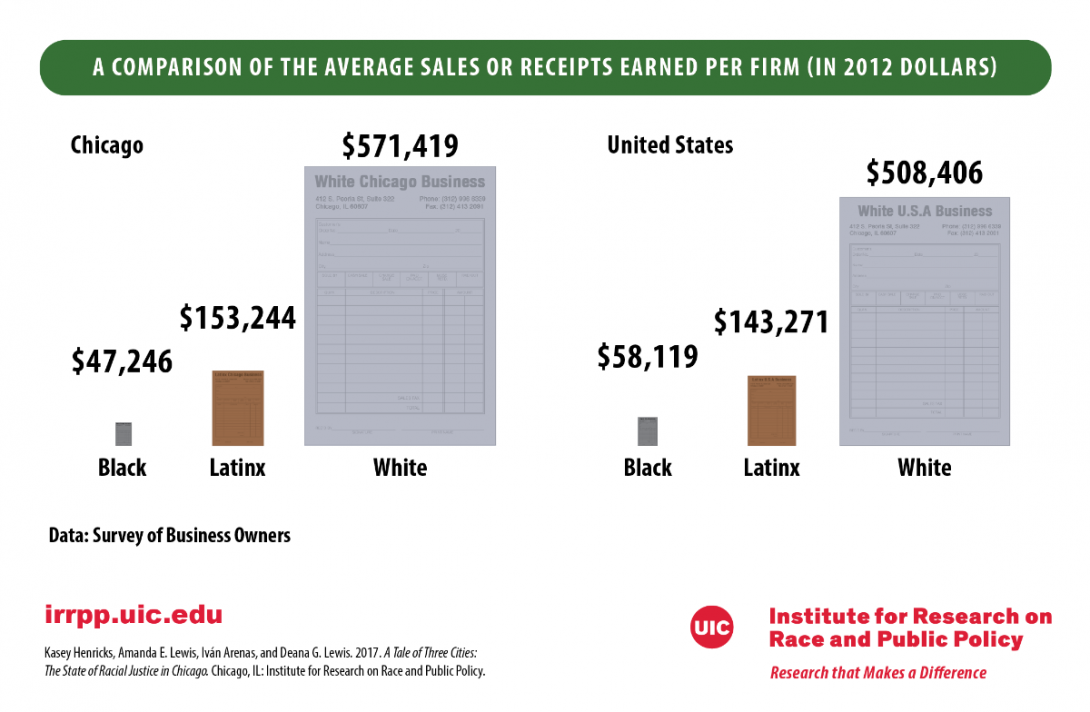
Recent reporting on which businesses have received Paycheck Protection Program (PPP) loans has shed light on how smaller businesses, many of them black and brown owned, lacked preferential relationships with banks and were therefore left out or unable to access PPP loans. As a graphic in the Tale of Three Cities: The State of Racial Justice in Chicago Report further notes, on average the yearly sales of black and Latinx owned businesses in Chicago and in the United States are much smaller than those of white owned businesses, making them much more vulnerable to financial challenges even as they were the businesses least likely to receive PPP loans.
How We Got Here: Insurance Rates

The number of black and Latinx Chicagoans making less than $15 an hour has been an important source of economic stress during the pandemic and, because jobs that make $15 an hour or less are most often those that have been labeled essential work, black and brown Chicagoans are at higher risk of exposure to the Coronavirus. As another graphic in the Tale of Three Cities: The State of Racial Justice in Chicago Report further points out, the Latinx community in Chicago has high rates of people that lack health insurance (18.5%) while around 10% of white and black communities also lack health insurance, compounding not only the challenge of dealing with the Coronavirus but also of dealing with other health risks.
Wages For Chicago Workers By Race
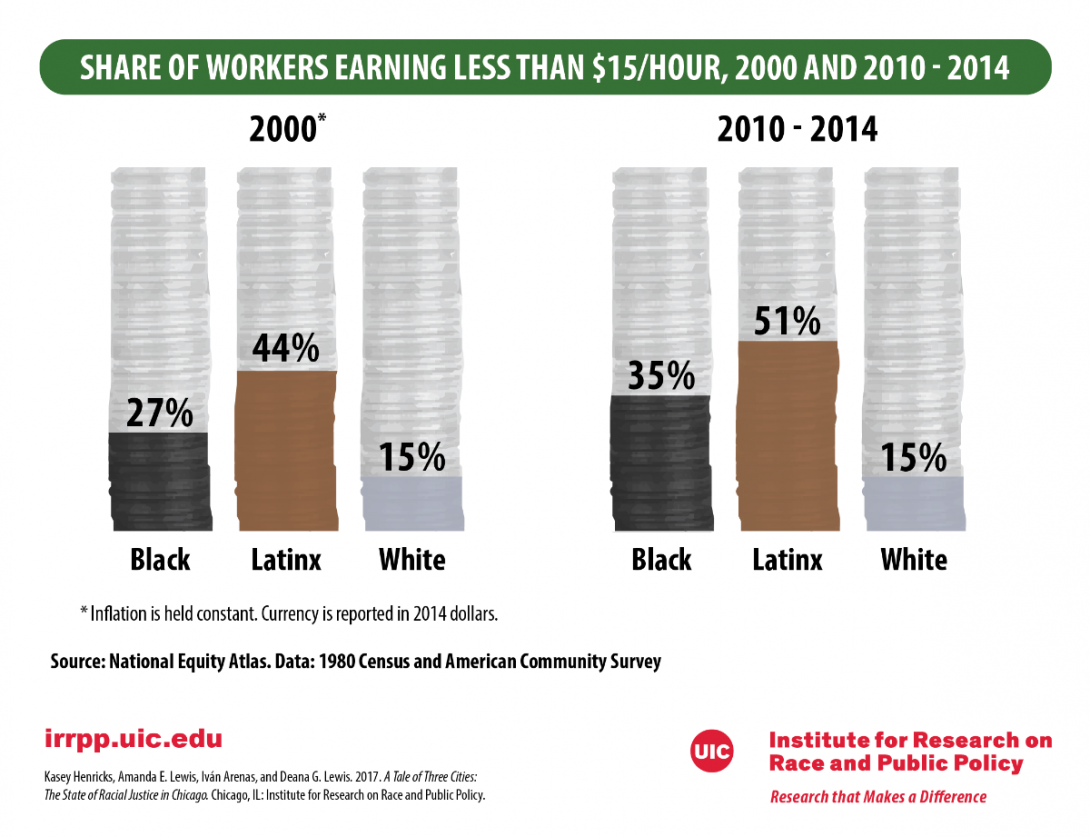
Since the 1980s the numbers of unemployed black and Latinx Chicagoans has been at two to three times the level of white Chicagoans. Compounding the ongoing unemployment crisis in communities of color is the fact that 35% of black and 51% of Latinx workers make less than $15 an hour. Moreover, as the graphic we shared in the Tale of Three Cities: The State of Racial Justice in Chicago Report demonstrates, fewer black and Latinx workers made over $15 an hour in 2014 than in the year 2000. Black and Latinx families are not only having to weather the pandemic with less financial resources than white Chicagoans but they also find themselves in the kinds of jobs that are deemed essential and are at higher risk of exposure to the Coronavirus.
Chicago Unemployment By Race
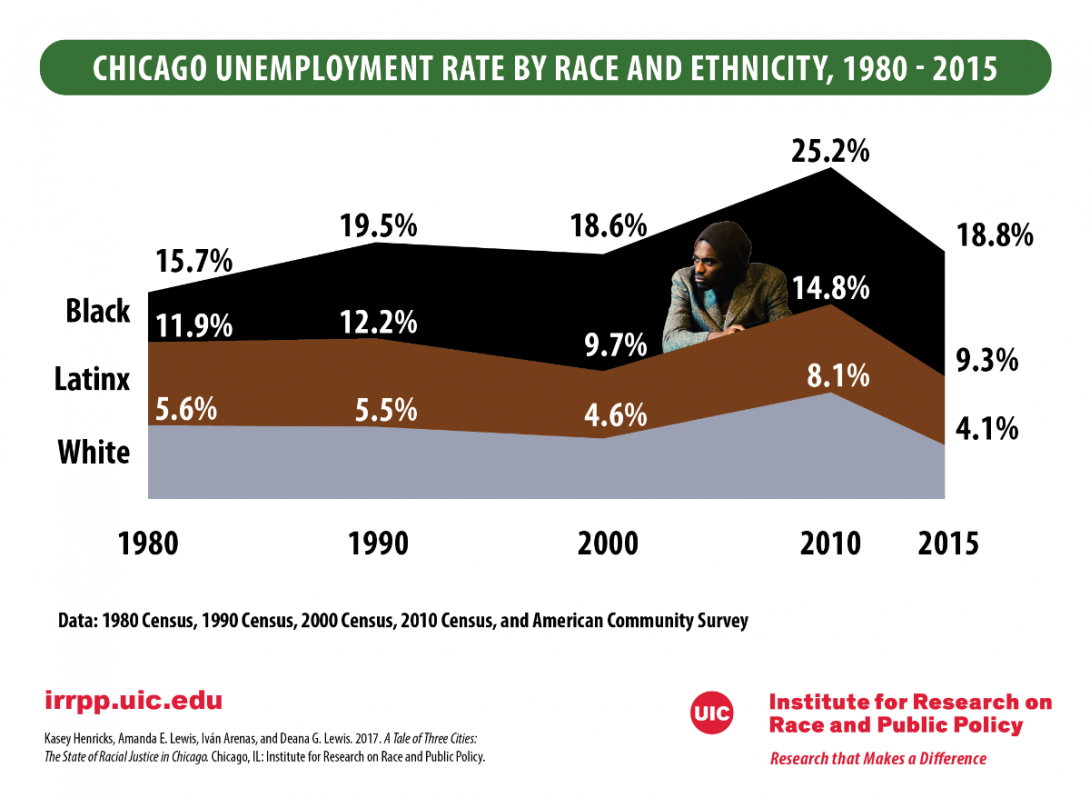
The unemployment rate in the country as a result of the pandemic has caused alarms and the response has been to pour in hundreds of millions of dollars into the economy and businesses. As we note in the Tale of Three Cities: The State of Racial Justice in Chicago Report, the level of unemployment that we are currently labeling a national crisis has been a daily reality for black communities in Chicago since the 1980s. However, there hasn’t been a marshaling of resources into these communities in response and the pandemic has only exacerbated these already devastatingly high levels of unemployment.
Rates Of Police Stops In Chicago By Race
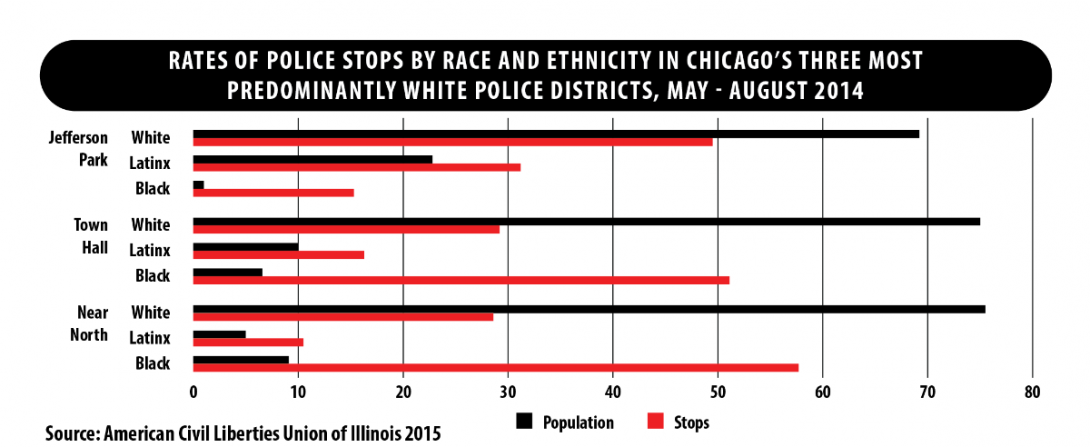
Calls to defund the police are rooted in the reality that police treat black and brown communities very differently from white communities in our nation. Another data point that our Tale of Three Cities: The State of Racial Justice in Chicago Report highlighted were the disparities in the stop rates for black, Latinx, and white residents of the city. Data from the American Civil Liberties Union of Illinois noted that, in a three month period in 2014, black people accounted for 72% of CPD stops while Latinx people were 17% of stops and white people were 9% of the total. As this graphic shows, black people are a highly disproportionate number of those stopped by CPD even in communities where the population of white Chicagoans is high and black and Latinx residents are relatively small.
Spending on Incarceration by Chicago Neighborhood
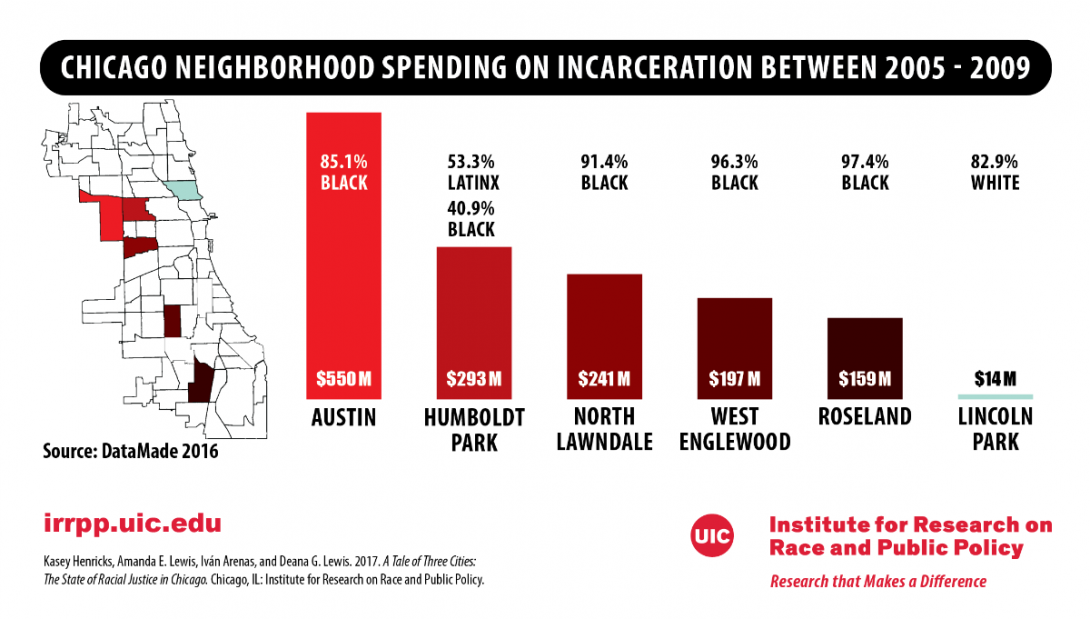
One of most striking data points that our Tale of Three Cities: The State of Racial Justice in Chicago Report highlighted are the differences in funds spent on incarceration in black and white Chicago neighborhoods. At the same time as majority black neighborhoods such as Austin are last in public investments in housing, education, and healthcare, these neighborhoods are receiving massive investments in policing and incarceration. What could Austin’s education system, employment opportunities, and healthcare options look like if the 550 million spent on incarceration between 2005 and 2009 were dedicated to those priorities?
Direct Expenditures on Criminal Justice
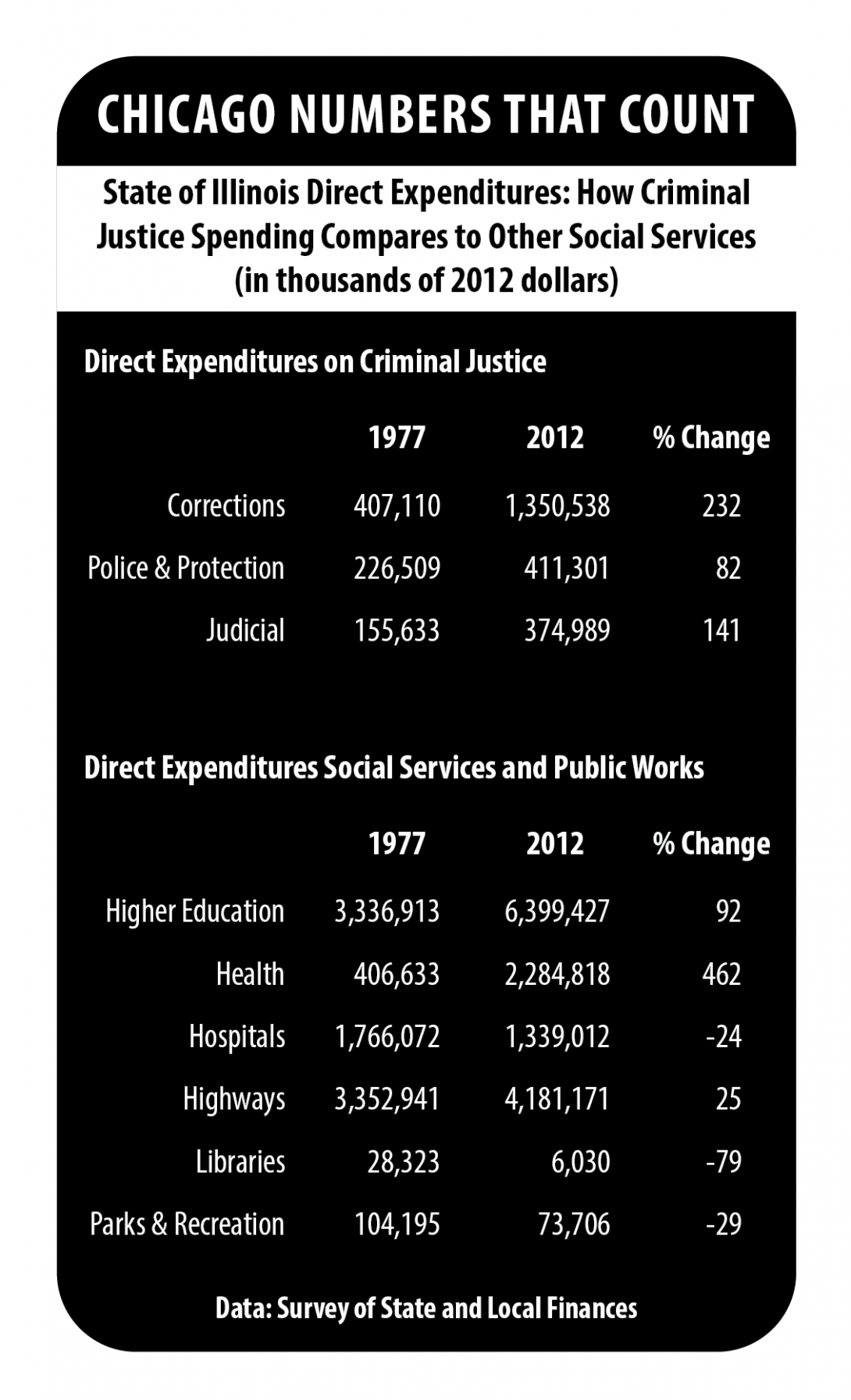
Calls to defund the police are rooted in the reality that police treat black and brown communities very differently from white communities in our nation. Calls to defund the police ask us to pay attention to skewed funding priorities where we continue to pour money into policing and the criminal justice system while divesting from social services and public goods.
The Institute for Research on Race and Public Policy’s Tale of Three Cities: The State of Racial Justice in Chicago Report pointed out that, in 2012, the annual amount of direct expenditures the State of Illinois spends on corrections was $1.35 billion. Another $411 million was spent on police and protection, and some $375 million was spent on the judicial courts. At the state level alone, that comes to roughly $2.1 billion. How did state spending on criminal justice compare to other expenditures on social services and public works? With the exception of healthcare expenditures, which increased 462% between 1977 and 2012, the growth of money spent on corrections outpaced every other major expense of the state.
Increasing spending trends on prisons stand in contrast to a decline in funding for public works and social services. More money is spent on criminal justice than on parks and recreation, libraries, and hospitals. Since the late 1970s, corrections spending has grown by 232%, a growth rate that is over two and a half times that of higher education. Spending rates for incarceration are densely concentrated among black and Latinx communities in Chicago.
Differences in CPD Disciplinary Action By The Race/Ethnicity Of Those Making A Complaint
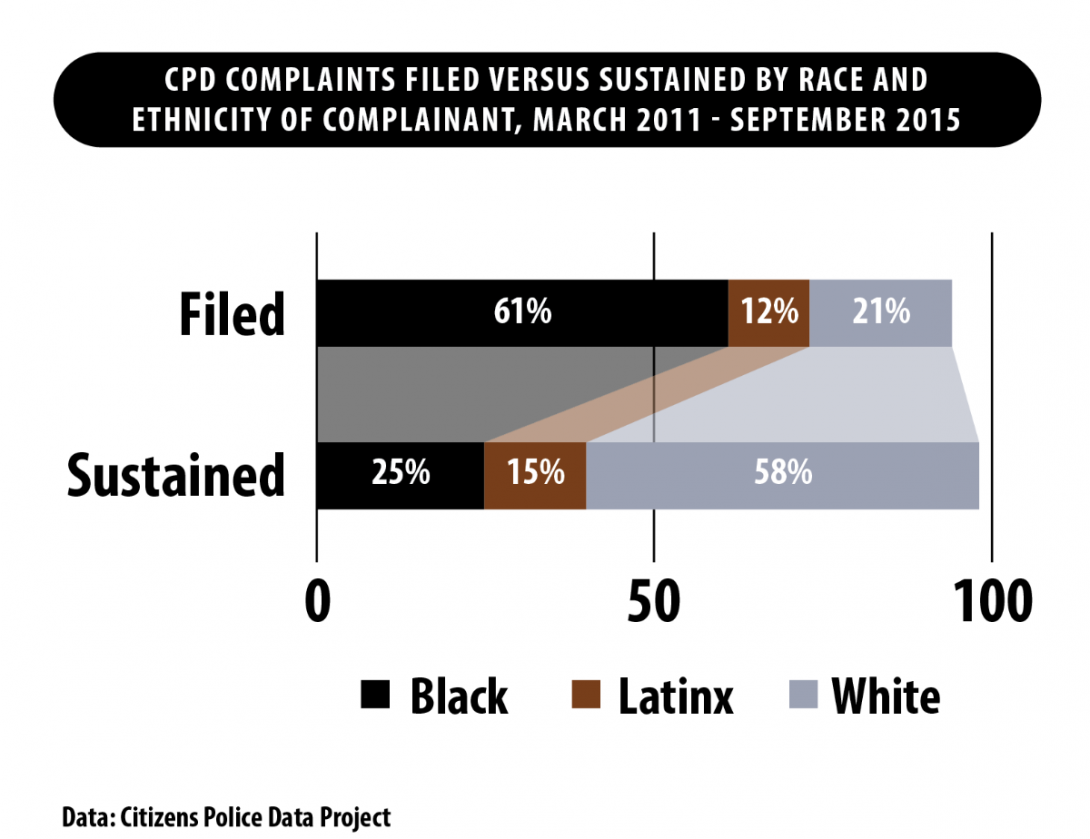
Beyond pointing out the outsized increases in spending on the criminal justice system and policing, the Institute for Research on Race and Public Policy’s report, Tale of Three Cities: The State of Racial Justice in Chicago Report noted that, between March of 2011 and September of 2015, over 61% of the complaints received by the Chicago Police Department were from black Chicagoans but of those only 25% were sustained whereas 21% of the complaints were from white Chicagoans but these accounted for 58% of the complaints sustained. Black communities are not only policed differently from white communities in Chicago, but when black communities register their complaints about problems with policing in their communities, they are listened to very differently by police than white Chicagoans.